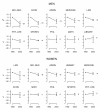Smoking differences between employees in faculties of the University of Tartu, Estonia, and changes during the country's transition
- PMID: 21385456
- PMCID: PMC3065408
- DOI: 10.1186/1471-2458-11-153
Smoking differences between employees in faculties of the University of Tartu, Estonia, and changes during the country's transition
Abstract
Background: A previous study found marked differences in smoking between employees in various university faculties in Tartu, Estonia, soon after the disruption of communism. The present study was conducted to see whether such differences still exist and how the patterns had changed during the country's first transitional decade.
Methods: All employees at the University of Tartu (UT) were surveyed for smoking habits by means of a questionnaire in 1992 and 2003. The present paper is based on respondents whose faculty or workplace was known (1390 people in 1992, 1790 in 2003). Smoking differences were assessed in terms of regression-based adjusted figures.
Results: While 20% of the male employees smoked daily in 1992, 13% did so in 2003, the figures for females being 10% and 7%, respectively. The prevalence of men's daily smoking varied between faculties and other workplaces in the range 4-30% in 1992, and 0-24% in 2003, with corresponding ranges of 3-21% and 0-10% among females. Men in the medical faculty in both surveys, and those in the faculty of philosophy in the second survey showed higher rates than men in most other faculties, as did women in the faculty of law in the first survey and those in the faculty of philosophy in the second. The figures were usually low in the faculties of sports & exercise, physics & chemistry and mathematics. The sex pattern was reversed in the faculty of law and also in that of economics, where the women smoked more than the men.
Conclusions: Even in this low-smoking academic community, wide smoking differences existed between the faculties and other workplaces. Faculties where physical or mental performance is of prime importance are leading the way towards a smoke-free community, while men in the faculty of philosophy and, paradoxically, men in the medical faculty are lagging behind. The reversed sex ratio in the faculties of law and economics may indicate women's intensified drive for equality in this transitional society. We assume that different professional cultures may introduce variations in smoking patterns, thereby modifying the course of the smoking epidemic.
Figures



References
-
- Cavelaars AEJM, Kunst AE, Geurts JJM, Crialesi R, Grötvedt L, Helmert U, Lahelma E, Lundberg O, Matheson J, Mielcj A, Rasmussen NK, Regidor E, do Rosário-Giraldes M, Spuhler T, Mackenbach JP. Educational differences in smoking: international comparison. Brit Med J. 2000;320:1102–1107. doi: 10.1136/bmj.320.7242.1102. - DOI - PMC - PubMed
Publication types
MeSH terms
LinkOut - more resources
Full Text Sources
Medical

